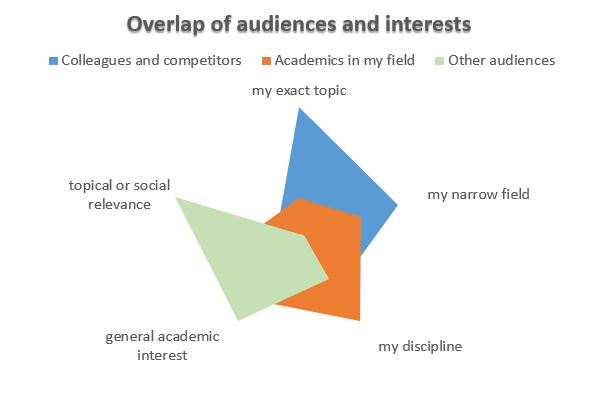Establishing your academic profile ultimately depends significantly on publication. You may already have articles, book chapters, conference proceedings or a monograph in your pocket, or you may be just starting to map out your future publication strategy. This blog offers some thoughts on different publication platforms and audiences. Crucially, thinking about how you can tailor your expertise to reach diverse publics – often by repurposing the same research into a new context – maximises your potential for output and impact.
Identifying different readers
It’s sadly true that a large part of the general population has no interest in your work, and never will have. We hope you have come to terms with that.
However, that doesn’t mean that only people within your narrow field of research will want to read about it, or that you should restrict yourself to audiences that are already established. We might think of you having a limited but highly involved ‘will read’ public and a less well-defined ‘might read’ public of significant size and potential.
You can think of this in terms of your academic ‘niche’ (or ‘niches’). There’s the very precise and detailed area of expertise of your personal research. You dwell in it, are perfectly adapted to it, and spend more time in it than anyone else. From this niche you occupy, closely related areas are readily accessible, and you can communicate with your neighbours using the same language and shared background knowledge. In this analogy you have long tendrils that reach out into the world and know these neighbouring niches intimately.
But sometimes you want to leave your niche – to hunt for food, attend an interdisciplinary conference, or publish in a journal with wider appeal. You scuttle across your familiar landscape, making for the edges of your territory. You need adapt a little for this environment – pulling in your tendrils a little – but you’re still well adapted to the terrain, and you can collaborate with others with nearby niches to get over particular obstacles. Access to this terrain brings many rewards, such as an uptick in citations, greater funding opportunities, and essential resources that you can take back to your niche, and perhaps refurbish it.
On another occasion, perhaps driven by the need to procreate, you must leave your niche a fair way behind, even daring to go beyond the boundaries of your discipline – even academia itself! Your tendrils must be adapted into sensitive whiskers; your scuttling legs into crampons for scaling the face of social media or popular publication. Your habitual language is stripped back to its basics, as you seek to communicate with beings of very different assumptions and priorities. Your basic interests – cytoplasmic division; Wittgenstein’s rule-following argument; the ontological limitations of critical realism – have no purchase here. However, relating your skills and discoveries to this wider world of politics and popular imagination doesn’t mean dumbing down your research, but considering and presenting it from a different point of view. This village of strangers can be told a story, throbbed out on your quickly re-evolved thorax, that connects to their own concerns, clarifies what it you’ve been doing in the little niche of yours, and creates potential new collaborations. Satisfied, you may return to your niche, emboldened, more employable, and brim-full with the sweet nectar of new ideas.

Ok, enough of that…
Your different audience can also overlap at strategic points, and different forms or topics of publications can meet their interests:

TASK:
Imagine your own audiences. Where do they overlap, and which platforms exist to facilitate communication there? What are your objectives for each publication – not just getting something published?
Journals
You will know from your own research which journals are the highest-profile, commonly called 4-star journals. Their editorial demands are a recognised marker of quality. Aim high when choosing your ideal publisher but, especially for the top rank journals, some realism is needed, too. Steel yourself for disappointments and have a back-up target if your first choice is not possible; take advice from experienced colleagues about where and when to submit. It is important to balance quantity with quality, since to publish regularly is both necessary and a significant achievement, but you do not want to ‘waste’ your best research on an easier publication that will not be as well noticed. Intelligent planning of your publication strategy should allow you to mix-and-match different levels and types of publication. Each of these audiences demand different kinds of writing, and we are going to explore some examples.
Specialist journals can be of great interest and value, but only to a limited scholarly community. These constitute your ‘will read’ audience, where you can go into the scholastic minutiae of your topic, assured of an engaged and highly knowledgeable response. Your writing here can be highly technical and assume considerable foreknowledge; it will be precise and well-founded in the current literature. This can be simultaneously the most comfortable and the most nerve-wracking kind of writing, since you are bound to have an engaged (and possibly passionate) readership who are, by profession, also going to be intensely critical; there is nowhere to hide. Counter-intuitively, although this kind of writing is designed to be objective and exact, it can feel the most personal, since you have worked so hard to craft every nuance and check every reference, date and figure.
In addition to knowing your home turf, make sure you have an overview of journals that cover your discipline more generally. Be mindful of your purpose in submitting a specific article, which may include also attracting ‘might reads’. Provide more background knowledge germane to your research and make a case for its relevance to the targeted scholarly community. Avoid writing that would exclude a more generalist reader and link your project with current trends in the discipline. For example, watch out for announcements of special editions of journals on a topic, or current ideas that are generating a lot of interest.
For any submission, but particularly more general journals, make sure you have familiarised yourself with the journal’s style (language, length, referencing, figures) and that you pitch the information at a suitably broad, but professional, level. For example, the advice to authors for Nature:
https://www.nature.com/nature-research/for-authors/write
Consider also:
- ‘Might’ readers will need to be captured quickly, since their interest will be provisional, and potentially fleeting.
- Readers may have English as their second language, so avoid colloquial or unnecessarily elaborate expressions.
- Have a title and abstract that are accessible and that explain the ‘so what’ of your research.
- The focus and the possible implications should be stated from the beginning.
Other platforms
Beyond these recognised academic publications, think about how your writing could have a wider impact, such as blogging. There are also more formal platforms that can combine academic rigour with public interest, such as The Conversation. If your research has an application to a pressing current topic, this can be a great way to approach it from a new perspective, but think about how you can convey in in layperson’s term. Aside from being an excellent way to boost your profile and improve your teaching, it’s increasingly a requirement in successful funding applications: funders will request a lay summary or justification.
You might be surprised what creates resonance; from archival discoveries to reflections on experimental method, you’re capable of bringing your passions to life. Some imagination and careful editing can turn the wide world of ‘might’ into an army of ‘will’ reads.

Further reading:
Rose, M., ‘How do I attract different audiences to my publications?’ in Publishing for Impact, Duke, D., Denicolo, P. and Henslee, E., (eds) London: SAGE Publications, 2020.
Dr Mike Rose, Researcher Development Training Officer, Doctoral College
